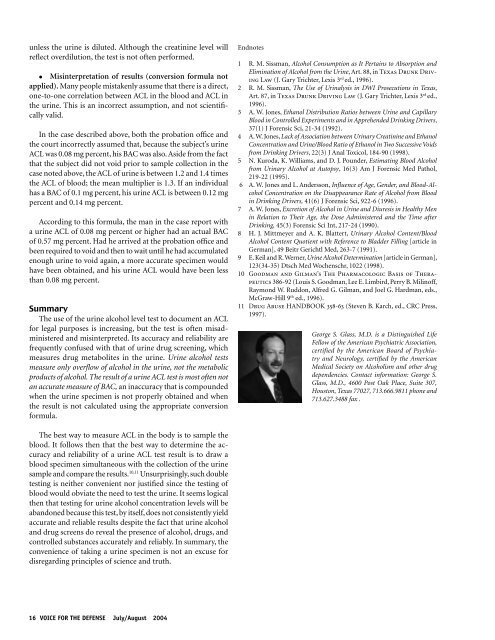July/August 2004 VOICE FOR THE DEFENSE 1
July/August 2004 VOICE FOR THE DEFENSE 1
July/August 2004 VOICE FOR THE DEFENSE 1
Create successful ePaper yourself
Turn your PDF publications into a flip-book with our unique Google optimized e-Paper software.
unless the urine is diluted. Although the creatinine level will<br />
reflect overdilution, the test is not often performed.<br />
• Misinterpretation of results (conversion formula not<br />
applied). Many people mistakenly assume that there is a direct,<br />
one-to-one correlation between ACL in the blood and ACL in<br />
the urine. This is an incorrect assumption, and not scientifically<br />
valid.<br />
In the case described above, both the probation office and<br />
the court incorrectly assumed that, because the subject’s urine<br />
ACL was 0.08 mg percent, his BAC was also. Aside from the fact<br />
that the subject did not void prior to sample collection in the<br />
case noted above, the ACL of urine is between 1.2 and 1.4 times<br />
the ACL of blood; the mean multiplier is 1.3. If an individual<br />
has a BAC of 0.1 mg percent, his urine ACL is between 0.12 mg<br />
percent and 0.14 mg percent.<br />
According to this formula, the man in the case report with<br />
a urine ACL of 0.08 mg percent or higher had an actual BAC<br />
of 0.57 mg percent. Had he arrived at the probation office and<br />
been required to void and then to wait until he had accumulated<br />
enough urine to void again, a more accurate specimen would<br />
have been obtained, and his urine ACL would have been less<br />
than 0.08 mg percent.<br />
Summary<br />
The use of the urine alcohol level test to document an ACL<br />
for legal purposes is increasing, but the test is often misadministered<br />
and misinterpreted. Its accuracy and reliability are<br />
frequently confused with that of urine drug screening, which<br />
measures drug metabolites in the urine. Urine alcohol tests<br />
measure only overflow of alcohol in the urine, not the metabolic<br />
products of alcohol. The result of a urine ACL test is most often not<br />
an accurate measure of BAC, an inaccuracy that is compounded<br />
when the urine specimen is not properly obtained and when<br />
the result is not calculated using the appropriate conversion<br />
formula.<br />
Endnotes<br />
1 R. M. Sissman, Alcohol Consumption as It Pertains to Absorption and<br />
Elimination of Alcohol from the Urine, Art. 88, in Texas Drunk Driving<br />
Law (J. Gary Trichter, Lexis 3 rd ed., 1996).<br />
2 R. M. Sissman, The Use of Urinalysis in DWI Prosecutions in Texas,<br />
Art. 87, in Texas Drunk Driving Law (J. Gary Trichter, Lexis 3 rd ed.,<br />
1996).<br />
3 A. W. Jones, Ethanol Distribution Ratios between Urine and Capillary<br />
Blood in Controlled Experiments and in Apprehended Drinking Drivers,<br />
37(1) J Forensic Sci, 21-34 (1992).<br />
4 A. W. Jones, Lack of Association between Urinary Creatinine and Ethanol<br />
Concentration and Urine/Blood Ratio of Ethanol in Two Successive Voids<br />
from Drinking Drivers, 22(3) J Anal Toxicol, 184-90 (1998).<br />
5 N. Kuroda, K. Williams, and D. J. Pounder, Estimating Blood Alcohol<br />
from Urinary Alcohol at Autopsy, 16(3) Am J Forensic Med Pathol,<br />
219-22 (1995).<br />
6 A. W. Jones and L. Andersson, Influence of Age, Gender, and Blood-Alcohol<br />
Concentration on the Disappearance Rate of Alcohol from Blood<br />
in Drinking Drivers, 41(6) J Forensic Sci, 922-6 (1996).<br />
7 A. W. Jones, Excretion of Alcohol in Urine and Diuresis in Healthy Men<br />
in Relation to Their Age, the Dose Administered and the Time after<br />
Drinking, 45(3) Forensic Sci Int, 217-24 (1990).<br />
8 H. J. Mittmeyer and A. K. Blattert, Urinary Alcohol Content/Blood<br />
Alcohol Content Quotient with Reference to Bladder Filling [article in<br />
German], 49 Beitr Gerichtl Med, 263-7 (1991).<br />
9 E. Keil and R. Werner, Urine Alcohol Determination [article in German],<br />
123(34-35) Dtsch Med Wochenschr, 1022 (1998).<br />
10 Goodman and Gilman’s The Pharmacologic Basis of Therapeutics<br />
386-92 (Louis S. Goodman, Lee E. Limbird, Perry B. Milinoff,<br />
Raymond W. Ruddon, Alfred G. Gilman, and Joel G. Hardman, eds.,<br />
McGraw-Hill 9 th ed., 1996).<br />
11 Drug Abuse HANDBOOK 358-63 (Steven B. Karch, ed., CRC Press,<br />
1997).<br />
George S. Glass, M.D. is a Distinguished Life<br />
Fellow of the American Psychiatric Association,<br />
certified by the American Board of Psychiatry<br />
and Neurology, certified by the American<br />
Medical Society on Alcoholism and other drug<br />
dependencies. Contact information: George S.<br />
Glass, M.D., 4600 Post Oak Place, Suite 307,<br />
Houston, Texas 77027, 713.666.9811 phone and<br />
713.627.3488 fax .<br />
The best way to measure ACL in the body is to sample the<br />
blood. It follows then that the best way to determine the accuracy<br />
and reliability of a urine ACL test result is to draw a<br />
blood specimen simultaneous with the collection of the urine<br />
sample and compare the results. 10,11 Unsurprisingly, such double<br />
testing is neither convenient nor justified since the testing of<br />
blood would obviate the need to test the urine. It seems logical<br />
then that testing for urine alcohol concentration levels will be<br />
abandoned because this test, by itself, does not consistently yield<br />
accurate and reliable results despite the fact that urine alcohol<br />
and drug screens do reveal the presence of alcohol, drugs, and<br />
controlled substances accurately and reliably. In summary, the<br />
convenience of taking a urine specimen is not an excuse for<br />
disregarding principles of science and truth.<br />
16 <strong>VOICE</strong> <strong>FOR</strong> <strong>THE</strong> <strong>DEFENSE</strong> <strong>July</strong>/<strong>August</strong> <strong>2004</strong>

















